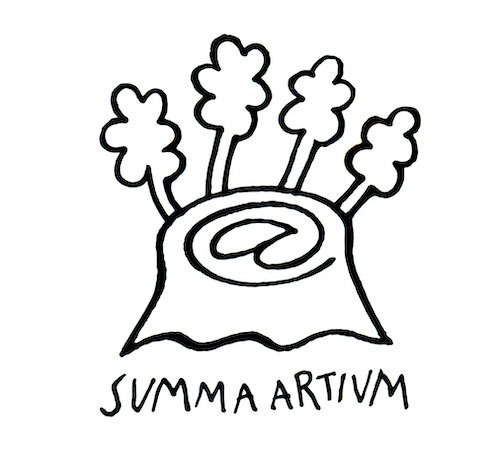I grabbed a hammer and smashed my reflection
Interview with Klára Kuchta
She ranks high among women who integrate aggression into their art. Her main media are textile, her own body, video, and, lastly, light. She lives in Switzerland but dreams in Hungarian.
Klára Kuchta mastered classical weaving techniques at the University of Applied Arts more than fifty years ago. In 1969 she participated in the second Iparterv Exhibition and, soon after, emigrated to Geneva. After creating monumental spatial textiles, she turned to performance and video art. In these genres her personal mythology reached its full potential. She overcame breast cancer, and her art gained a universal mode of expression in the intangible medium of light. In 2004, the kinetic light installation presented in the Kiscelli Museum’s former church nave seemed to transport visitors into a new dimension. To this day, she dreams in Hungarian, but she has no plans to move back home. She has deliberately spoken about momentous events in her life and the power of nature and faith during the pandemic.
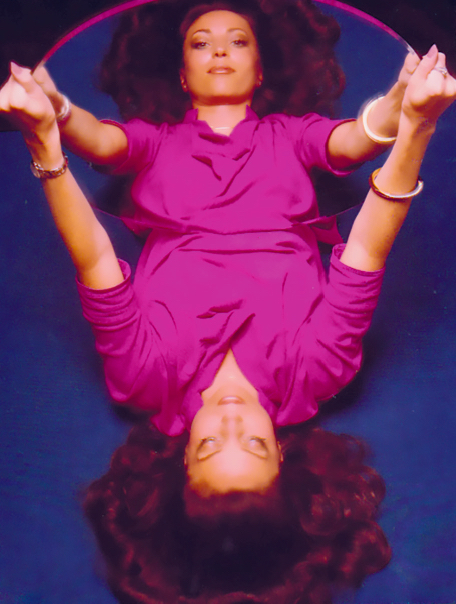
Viola Lukács: Tell us a bit about what you were like as a child.
Klára Kuchta: My family was certainly open-minded. As a child, I had to learn about all the religions of the world in order to respect, understand and accept otherness and myself. My aging uncle was a deacon in Zagyvapálfalva, in Nógrád County, Hungary. At the age of ten, during the summer vacation, they took me to stay with him. I ran away, because he only knew how to deal with good children ... I had a very independent spirit even then. I grabbed my little bundle, packed some food in the night, and just like Uncle Pósa in Mr. Mackó's Travels, I set out alone on a kilometre-long walk to the train station. News, however, spread faster in the village than I had anticipated: the women informed my uncle that I was waiting at the station for the train to Budapest. My uncle did not try to stop me. He told everyone to leave me alone and not upset me and secretly arranged for an elderly passenger to look after me. Just like our family, this passenger had also been deported and was travelling to Budakeszi that day. The old man came up to me on the train and said, “I am glad to see you, I hear, you would like to go home.” To which I replied proudly, "I have no reason to stay here any longer, because my uncle wants to hammer me into one of the missing isinglass cubes of the bedroom door!"
To this day, this kind of unusual withdrawal and isolation, sometimes out of compulsion, sometimes voluntary, is typical of you. Somehow it is arecurring motif in your life: deportation in 1947, emigration to Vienna in 1969, and eventually settling in Geneva in 1970. And internal immigration, which was probably a consequence of your illness in 1987.
Socialism even with a human face was not invented for me, I had to leave. This, however, had a price, loneliness and self-dependency are corollaries of the immigrant life. But it also came with independence, for which I have always fought. I am not a militant feminist, I am one of those who live and nourish emancipation every day through their personal and professional existence. The agenda against oppression and exploitation. I consider our conversations important because they allow for the historical and political events known from the grand narratives to appear in a different light, so the picture will be a nuanced one.

Was it a question that you would become an artist?
My mother wanted me to learn to play the piano, as she herself played beautifully, but it did not go so well for me. She understood that I would not become a musician, especially not a pianist. Involvement in the fine arts, creativity, these things were taken for granted in our family. I had always been interested in the visual world. I was constantly drawing and painting, so they started me off in that direction.
What are your memories of your first “great breakaway”?
The memory of the deportation is a terrible feeling. I was six years old in 1947, when, under the Beneš Decree, a controlled population exchange was carried out between Hungary and Czechoslovakia, two countries that were both under Soviet influence at the time. My father and brother had already fled to Hungary, but the seven of us, together with my grandparents, traveled in a cattle wagon. My mother cried a lot. We had to leave everything there, the estate, all our belongings. We particularly regretted having to abandon the house which had been built by my grandfather and where I had been born. It was a villa built in the Jugendstil style in the center of Rožňava, and it still stands, but -it is now used by the Slovak police. What was even more disquieting was that no one knew anything about what would happen to us, where we would end up. One of the methods of terror was to provide no information and then exploit the anxiety that resulted from this uncertainty.
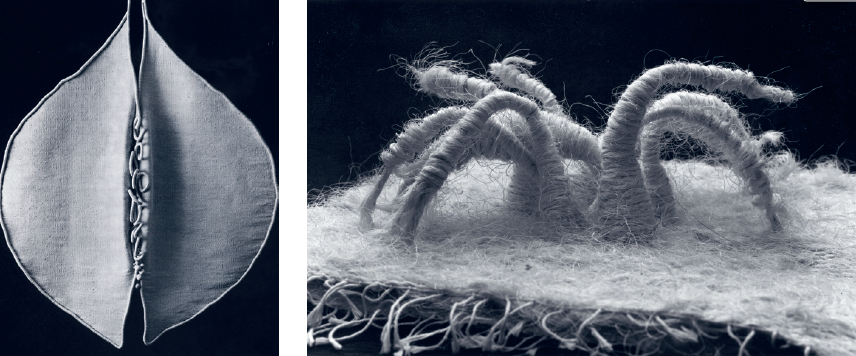
How many days were you underway?
I have no idea; the whole experience has condensed into a spasm. To this day, I feel like my stomach is tied in knots when I hear the switching of railway tracks. The sound remains, and it brings back the feelings of fear and hopelessness. My brother Nándi was also completely shattered by the trauma of the escape: at the age of nine, he had to endure the flight to Hungary, crouching or lying on his stomach in a wagon full of potato sacks. I remember that the train was stuck in uninhabited areas during the day and could only continue its journey by night. Then we were placed in a refugee shelter in Angyalföld, and eventually were given this house, where we are now sitting, in Rákóczi Street in Budakeszi with old trees around us. Despite the hard times, I love this place, the air is fantastic; even before the war, tuberculosis patients came here as part of their treatment.
The Swabians in Budakeszi were hard-working people; then in 1946, from one day to the next, they were deported. They left in tears, and we went into their homes in tears. The early days were problematic because the village made us feel as if we had no right to be here and that we should be grateful to have a roof over our heads.
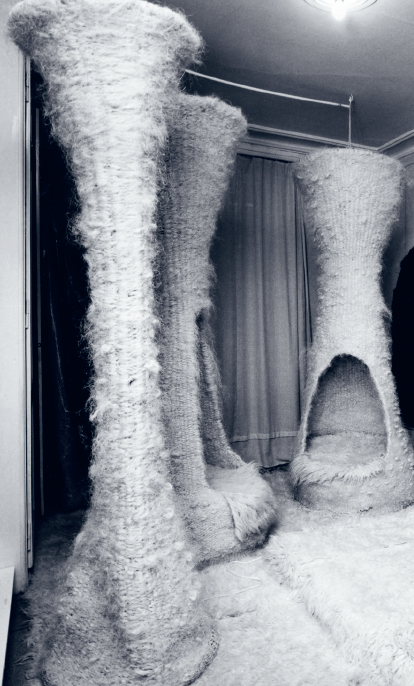
Was Noémi Ferenczy one of your instructors at the University?
I met her in 1955, when I was preparing to enter the gymnasium. TapestryWithin textile art, tapestry was the pinnacle for me within textile art, and I owe this early realisation to her. That’s how I ended up applying to the University of Applied Arts. Originally, I wanted to become a sculptor. At, at the time around graduation, I attended private courses taught by Pál Pátzay in the Mulberry Garden of the University of Fine Arts. I was interested in large-surface, monumental works. Tapestry, mosaic, fresco/seco. It never occurred to me to become a textile designer, but during my college years I mastered traditional weaving techniques. Around that time, textile art began to expand to incorporate more possibilities. On the one hand, in Europe, Lurçat revived the tapestry tradition: the manufactory in Aubusson produced carpets by famous, modern painters and sculptors in mass quantities (Picasso, Hantaï, etc.). In Budapest, the circumstances were complicated by Stalinist propaganda, which in art required strict compliance with the Soviet model. At the university, painting and sculpture were the most ideologized majors, while we had more opportunities for experimentation and self-expression. There were two reasons which might explain this: there were basically only women in the textile department. The cultural leadership of the time did not take this major very seriously; over, over the years it was alternately moved to the University of Fine Arts and then back to the University of Applied Arts. Even with all their technical challenges, tapestry and wall hanging are a fine art for me, but at the same time, I had no connection to the Socialist Realist-style tapestries made to order by the central government. Before I left the country, I was invited to participate in the second Iparterv Exhibition in 1969. I, where I exhibited one of the textiles I created for an exam at the university. In his review of the exhibition, Géza Perneczky mentioned me as a promising fine artist. Of course, after graduating from college, I had to rethink my artistic program.
I was most interested in possibilities regarding changes in dimensions, so later, I began weaving three-dimensional spatial textiles instead of two-dimensional tapestries. This is how I ended up making the columns made from sisal and, as well as The Barrel of Diogenes created in Geneva, which I named l’environnement habitable (habitable spatial creations). A uniquespecial feature of the sculptures and objects made from sisal is that they were made by circular weaving, so they have no seams or cuts. Rather, the yarn or, if you prefer, the endless path of the line forms the space.
I wrote the Socio-Economic Manifesto in 1973, in which I carefully formulated the technical and visual criteria of my art, which I continued to adhere to, so that by 1974 I was already experimenting with new materials and modes of expression.
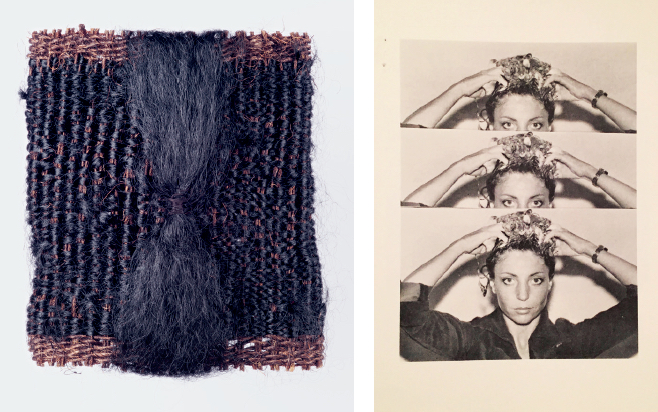
My braid, the fashionable hairstyle of the 1960s, which I had cut off, happened to end up my hands, and from it, I weaved a small object, the first attempt to “square” the hair. I was planning another exhibition, but it eventually became a ten-year-long research project on human hair. Hair appeared in my works as material, as a medium, and as information. With this, I moved into the field of economic life, including areas such as consumer culture, more specifically the expansive cosmetics and beauty industry, not to mention the sociological, phenomenological and cultural historical readings of hair. This could still be further expanded on, but in reality, it was the human being which became the focus.
With this, I became involved in the conceptual art movements, which by then were already ongoing. Between 1975 and 1978, I conducted sociological and economic surveys that were exclusively related to hair. The first artistic creations drawing on this research were the Tableaux Socio-Economic (Socio-Economic Tableaus), which I exhibited in 1978 at the Isy Brachot Gallery in Brussels. Beuys, Buren, Opałka, Panamarenko, Gina Pane and Rauschenberg were also among the gallery’s artists. At the time, Isy Brachot matched, on a European scale, Leo Castelli in New York. That same year, Pierre Restany invited my performance Blonde Venetian, and he made a full floor available to me at the exhibition he organized at Palazzo Grassi. This was the exhibition Venerezia Revenice that the New York University presented at the 38th Venice Biennale. In Blonde Venetian, I combined research on the local history of hair dyeing with the representational and identity-political approach of the beauty ideals of the age. This is how I became a blonde Venetian with blonde streaks, done with a traditional procedure and utensils from the Renaissance era. It was done by Alexander, the renowned master hairdresser, as part of the performance. This, by the way, is the first documented method of hair coloring in modern Western history. Wives of well-to-do Venetian merchants would contentedly sit in the midday sunshine on their palace terraces for hours, while their servants occasionally sprinkled their hair with a special mixture made from water from the canal (rich in urine), saffron, and lemon juice. As a result of oxidation, the melanin lost some of its color, resulting in a special reddish blonde. This fashion, which was also described by Pietro Bembo, was developed among the aristocracy and wealthy merchants, but it then spread among the common people as well. Portraits by Titian have preserved this fashion for posterity.
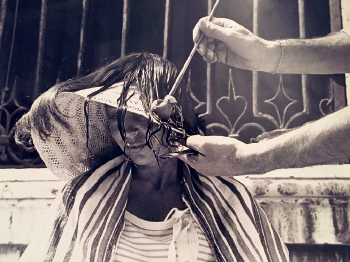
For the past fifty years, the mirror has been a recurring motif in your art. How has its meaning changed over time and concerningwith respect to the different themes of your works?
The mirror always refers to reflection, in a physical, social, psychological and philosophical sense. Following the hair theme, I also used a mirror in my examinations of space and perception. The mirror was also present in the laser-dial clock and in some of my light works.
But allow me to start at the beginning. The mirror played a vital role in the 1978 Blonde Venetian and the later film (Etre blonde c'est la perfection, 1980). “Being blonde is perfection itself”: this beauty ethos cliché was the refrain of the poetic narrative that accompanied the performance. I simply sat on a plane of mirror, looking at myself; my beautiful chestnut-brown hair, as I continuously replaced the wigs on my head with an increasingly lighter shade until it was completely blond. It was flashy blonde, but not white, but rather the platinum blonde type like Monroe’s hair. It was a slow, introverted process, during which I reflected on how much I resembled myself, that is, the image I formed of myself. Finally, I grabbed a hammer and smashed my reflection.
Though I usually plan the way in which my performances unfold, improvisational gestures are common, a moment here and there when I can’t and don’t want to control the situation – breaking a mirror, cutting a lock of hair, smashing through a paper wall. Communication or aggression? In which direction does the story turn?
Perhaps the best example of this is the 1979 performance that I first presented in Antwerp. We redid in 2019 at MAMCO in Geneva and again within the framework of Gallery Weekend in Brussels. My use of the plural form is significant here because the audience assumes the real lead role. I remember perfectly the first High Value Sample (Échantillon de Grande Valeur) performance at the ICC in Antwerp. I dyed my hair in the morning, and in the afternoon, when the audience had gathered, I cut some of it off. Then, with a large pair of scissors in my hand, I turned to the audience and asked the question: who was willing to let me cut a lock of their hair and then exchange it? The women with beautiful hairdos immediately stood up in shock and left, they were happy to come to the show, but they were hardly going to accept this challenge. Such an act of aggression. It was the men who were more inclined to stay… until it was their turn (she laughs). It was interesting to see how, forty years later, this proportion changed considerably, that there was great interest regardless of biological sex and gender, and especially among young people. These events regularly dragged on into the night, but it was good that communication was initiated, and my hair collection grew.

Why is cutting hair so frightening?
Possibly because of old beliefs, myths that in different cultures attributed magic powers to hair in various ways. Anthropologically, cutting hair can be regarded as a ritual act, which in modern times has been amended with political meanings, referring to hygiene and other normative principles. I remember how, under communism, boys were forbidden to have long hair, and Western hippies also rebelled against the extremes of imperialism by growing their hair out. In the period ending with the L’Art Socio-Economic program, I dealt in depth with the act of cutting hair in connection with the biblical story of Samson. Cutting someone’s hair can be seen and experienced as a kind of mutilation, but at the same time, in today’s society, it symbolizes the state of being well-groomed. I was interested in this conflict: where is the line of aggression drawn? Is there such a thing as non-violent communication?
Related to this is the story in which the locks of hair of a couple in love - like an extension of their souls - are intertwined, creating a kind of third special entity. In 1977, Marina Abramović and Ulay recorded their performance Time Relation in a studio in Bologna, in which they sat together back-to-back with their hair tied together for seventeen hours. They then traveled south, to Sicily. Then, with their characteristic ceremoniousness, they cut off the intertwined strands at dawn and brought them to me as a gift. As a memory of our friendship, I mounted the relic in a frame, and it thus became perhaps the most exhibited piece in my collection of hair locks.
What language do you dream in?
Probably in Hungarian. But my thinking is humanist and universal. Through art, I was able to cast off linguistic and cultural shackles. My favorite medium is light, which has no gender, race, or constructed identity.
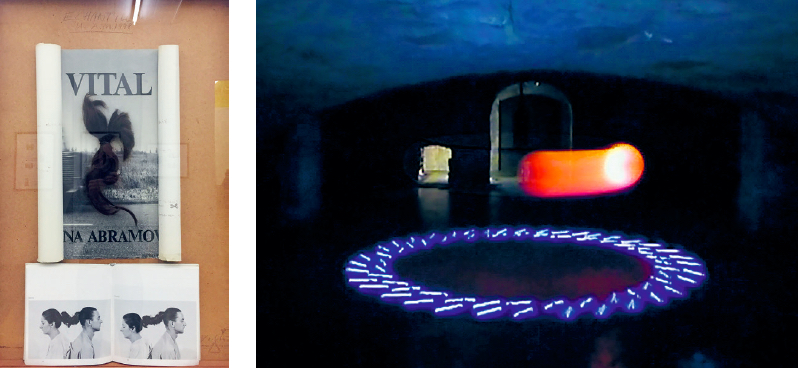
As a biological and social being, the human being was the starting point of your conceptual program; at the same time, from the mid-1970s, environmentally conscious education and recycling also gained an important role. For what purpose did you create the Centre de Creation Libre project space?
It came mostly from an inner urge, due to my upbringing. One only had to look around. Existence is also a responsibility, not just in terms of individual wellbeing, but also in the context of the environment and in the life of a chosen community. I was driven by the overarching need for conscientious behaviour that extended to everyday life. In 1974, I found a book on the street which was a rather banal reading about the culture of “bric-a-brac” (collecting trinkets, ornaments). That’s when the idea of holding creative classes for kids in my studio, where we would only use trash and found objects, occurred to me. At the time, recycling was considered by the urban, civic society merely as an artistic gesture; the concept of ecofeminism only gained ground in the 1980s, and only after that did the environment become a political issue. From these classes, the (re)creation centre called Centre de Creation Libre was formed in 1979 with the support of the municipality of Geneva. It gave both children and adults the opportunity to experiment. On Saturdays, we collected trash in the parks and in the nearby forests, and we selected the objects and materials that seemed interesting to us and made wonders from them or from gifts of nature such as fallen leaves and buds and fruits.
The creative workshop, which focused on ecology and eco-conscious living, was active between 1979 and 1992. Then in 1994, my similarly innovative project Le bonheur de la poubelle, être la plus belle (The joy of the trash bin, to be the most beautiful), received a state prize from Switzerland.
Your series showing a systematic display of medicine vials bears a striking resemblance to Damien Hirst’s installation Medicine Cabinets, but your works were created earlier. What was the motivation for making art out of a collection of medicines?
That’s an interesting parallel. Medicine vials placed side by side present an abstract but at the same time fairly direct portrait of society, just like the several tons of trash that people produce every day, even in a city the size of Geneva. This portrait draws attention to the importance of mental health. At the same time, on the social level, it also raised the question of the responsibilities of pharmaceutical companies. I even contacted a few of the larger companies, but they weren’t really keen on talking to me.
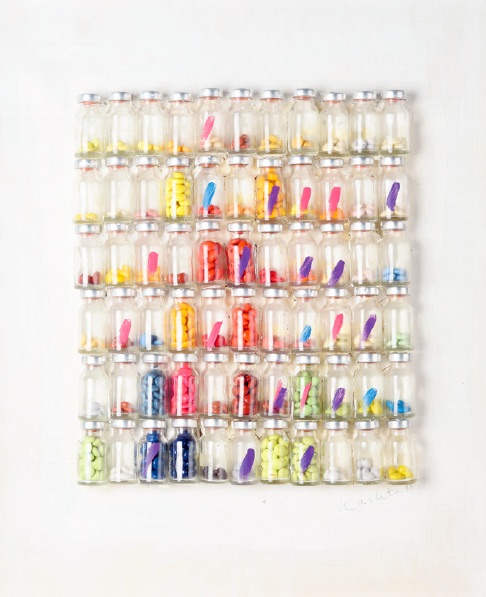
In 1987, following the tenth year of the L’Art Socio-Economic program, you were diagnosed with a malignancy in your breast. The surgery was performed unexpectedly, during a routine examination, and the difficult recovery process required all your energy. How did your relationship to yourself and to your environment change?
I didn’t acknowledge the disease, I didn’t accept it, I regarded survival as a task. I didn’t talk about it, close friends helped me, and I was lucky, because a drug which was in an experimental phase at the time worked for me. However, with it came chemotherapy, isolation, and depression. I endured a lot, and it took me twenty-five years, but I did it! I am grateful and I know I wouldn’t have been able to do it without friends.
How did illness affect your art?
I had to decline a list of invitations; a solo exhibition at the Museum of Modern Art in Antwerp, the film festivals in Solerno and Locarno, I could go on and on. On the other hand, art gave me strength to live. I am convinced of the healing power of creativity. At the time, I was making mandalas, and I started meditating regularly. Prayer has been important to me since childhood, it is personal therapy, they call it a mantra in other cultures. To this day, I practice this, but of course it is not fashionable to talk about the relationship between spirituality and creation. But what remains of art if we deny its spirituality?
How have the Covid-19 pandemic and its effects on society influenced your life?
We must live responsibly in the world! I take care of myself and others as well. I will not be traveling to Hungary anymore this year, but I can work really well from a distance on my oeuvre catalog, which will be published next year.
The condition of “confinement,” of isolation, is not unfamiliar to me. On the one hand, it reminds me of the long and often harrowing period of my illness. On the other hand, making art as a creative exercise usually takes place in the silence of my solitude. Previously, I had always made all my tapestries myself, which in each case required several months of steady work.
What worries me most are the consequences of the paralysis that pervades society. The constraints, the lack of direct physical contact, the financial crash, together with and general insecurity traumatize all of us. Art has a major role to play in the area of mental healing, and it would be good if society and the decision makers who are in charge would recognize this.
It is increasingly likely that in our accelerated, globalized world, these viruses will spread from continent to continent. I think ecology has benefited from restrictions on production and travel. Thus, the current situation provides a good opportunity to recognize the values inherent in a slower pace and in our immediate environment.
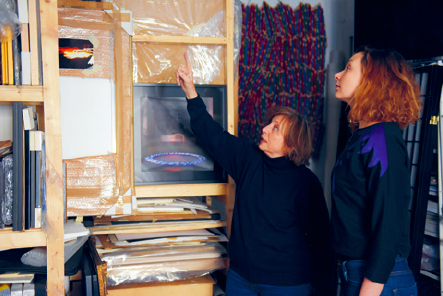
Our conversations began in 2014, when I chose the oeuvre of Klára Kuchta, particularly the period of the 1970s, when she was engaged with using hair, as the subject of my research. I examined the radical process as she turned from creating spatial textile installations to using herself and the hair of others as her medium. In my MA thesis Do Not Trust the Mirror - Curating in Conversation with Klara Kuchta, I tried to define this as an everyday activity of an immigrant woman. After many years, her work came into the spotlight again: in 2016, Violuk Contemporary received the Artmagazin award for best booth at the Budapest Art Market, where early works of Klára Kuchta were shown for the first time in many years. Since then, Kuchta has been invited not only to Budapest, but also to Vienna, Geneva and Brussels, and preparations are also underway for a group show in New York and an individual exhibition in Berlin.
The translation of this article was created with the support of Summa Artium.
